® Endo–Exo Implantation systems
“Endo-Exo- implantation systems are made for prosthetic rehabilitation after limb-amputation, which makes the conventional socket prosthesis unnecessary…
The physiologic course of motions during ambulation as well as the human anatomy have been taken into account and served as the archetype during development of the EEP.
Table of Contents
History of Osseointegration
In 1990 first implantations of osseointegrated, percutaneous (skin perforating) femoral prostheses was performed by R. BRANEMARK, who provided a bilateral above knee amputee with an intramedullar (inside the bone) force carrier to which the conventional exo-prostheses could be attached. This idea derived from findings made with tooth-implants. BRANEMARK’s father had invented tooth-implants, which are also directly attached to the bone to allow fixation of an artificial tooth. This system has found worldwide appreciation and is nowadays performed very often.
At the ISPO World Congress 2010 in Leipzig, Germany BRANEMARK reported by now more than 200 patients who had received his osseointegrated system mainly after traumatic amputations at above-knee, above- and below-elbow as well as thumb level.
The group in Lübeck, Germany around Dr. ASCHOFF can look at more than 200 patients that have been operated in Lübeck itself and other patients in different places in Germany and other European countries as well as Australia. Now adays these kind of surgery has been done more than 1000 cases all over the word.
Why Osseointegration?
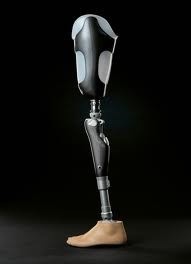
People with above or below knee amputations seek to return to a mobile lifestyle. Conventional rehabilitation uses a socket prosthesis, which is fixed to the soft tissue of the remaining amputation stump via suction or vacuum. The artificial knee joint and/ or lower leg prosthesis can then be attached to the socket. This enables the patients to walk without aids but there are several challenges in the use of a suction prosthesis. One important factor is the length of the remaining stump because it determines the lever arm and the force, which has to be applied for conducting, guiding and controlling the prosthesis. If the socket does not fit properly it can create skin irritations of the soft tissue, which may lead to sores, ulcera, chronic inflammation with abscesses and pain.
Moreover, the remaining stump length correlates with the energy expenditure during walking and an amputee uses on average 70% more energy than an able-bodied person. These difficulties can result in a poor gait with negative effects on the remaining musculoskeletal system. This often leads amputees to utilize walking aids or even a wheelchair.
Hence a prosthesis that avoids the skin and soft tissue interface is desirable for different reasons:
• skin irritation due to friction, chaffing and squeezing
• an increase in sweating and heat rashes
• inflammation, bruises and haematoma, pressure marks and even deep skin injuries
• dissatisfying fit of the prosthesis due to variation of weight and stump volume
• pain and missing comfort also during sitting
• hygienic problems
For a lot of amputees, it is therefore difficult to find their way back into an active lifestyle or to the working force. Often, they cannot perform the kind of activity and sports, which they would like to enjoy and they have to rely on the help of others during everyday life. Because of the mentioned difficulties some single-side or bilateral amputees even depend on a wheelchair permanently.
An osseointegrated, transcutaneous implant creates an alternative to these problems. “Osseintegrated” means “fixed to the bone” and transcutaneous is “perforating the skin”. With this system the prosthesis is directly attached to the bone and a socket or suction prosthesis becomes unnecessary and dispensable.
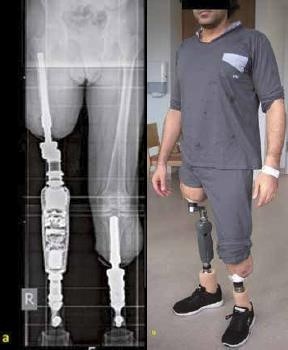
What does Endo – Exo - Implantation systems ® mean?
“Endo-Exo- implantation systems are made for prosthetic rehabilitation after limb-amputation, which makes the conventional socket prosthesis unnecessary…
The physiologic course of motions during ambulation as well as the human anatomy have been taken into account and served as the archetype during development of the EEP. Thus, load during walking is transmitted again through the remaining bones of either thigh or lower leg, depending on the level of amputation. As a consequence, also hip and/ or knee joint are loaded more physiologically.
The manufacturer “ESKA Orthopaedic GmbH” is well grounded in the field of Endo prosthetics. Due to use and interplay of state-of-the-art materials this new prosthetic technique is made possible.
The EEP is directly implanted in the remaining bone and therefore secures a long-term and safe connection between patient and prosthesis.
The endo-exo prosthesis (EEP) Construction
(The inner module (endo
Bridge Module
The EEP is made up of several modules. They can be subdivided into an inner module and an external module.
The inner module, the so-called endo (stem), is directly implanted into the remaining bone (i.e. femur, tibia or humorous).
One special feature of the implant is the patented Spongiosa-Metal® II surface. This surface allows the bone to grow through its three-dimensional grid structure (osseointegration), which secures a stable fixation of the prosthesis.
The dual cone adapter connects the internal and external modules. Fixed internally, it leads out of the stump and perforates the skin at the so-called stoma region creating a direct pathway from the inside to the outside components.
The silicone cover is used to protect the de-scribed stoma. The sleeve and the rotation disc serve as mechanical connections for the following knee connecting adapter, the artificial knee joint and/ or the lower artificial limb prosthetic system. All the artificial joint components can be quickly and easily linked to the internal-prosthesis using the knee connection adapter.
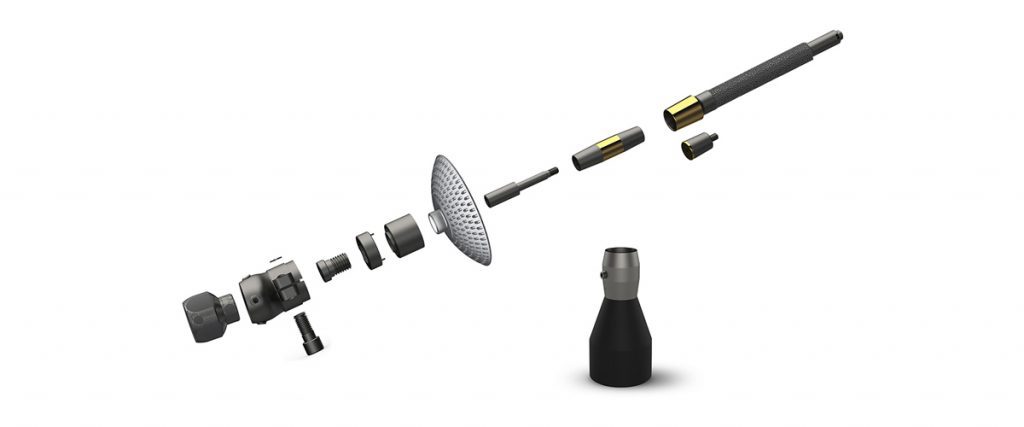
Advantages of the EEP
• An enhanced mobility of the joint
• A more effective use of the remaining muscles within the pelvis, the thigh and knee without the stump being forced into a predetermined form
• A considerably more effective load transmission to the exo prosthesis
• Less energy consumption during ambulation and less feeling of weight
• A much better comfort also while sitting
• A wider range of motion and free movement in all levels, not inhibited through the annoying and bothersome edges of a socket regardless whether you are laying down, sitting, standing, or walking.
• Prevention of low back pain.
• Prevention of cardiac and kidney problem
• Decrease the usage of energy compare with socket prostheses
• Useable for short residual limb
• Safe and smooth gait pattern
• The hip joint is claimed in a natural way
• Any weight or fluid variations of the stump have no effect on fit or functionality.
• No bulky socket which provides a natural streamlined look in clothes.
• Easy Handling: The exo-prosthesis can be attached and removed in only a few seconds. In contrast to the conventional socket prosthesis possible variations of the stump’s volume have no impact on the alignment of the prosthesis.
• There are no skin irritations due to chaffing, sweat or heat so that the prosthesis can be used for a longer period of time without causing pain, discomfort or mobility constraints.
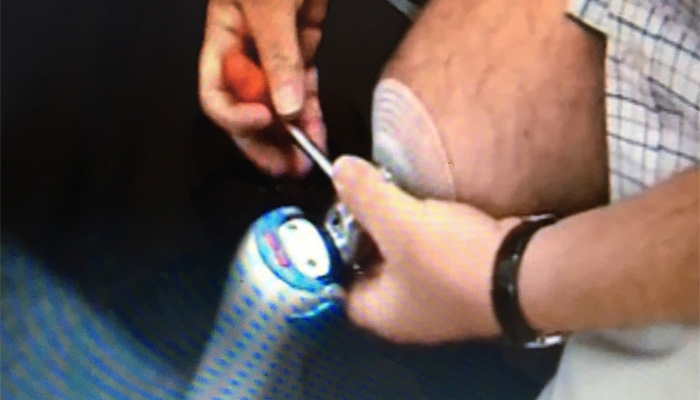
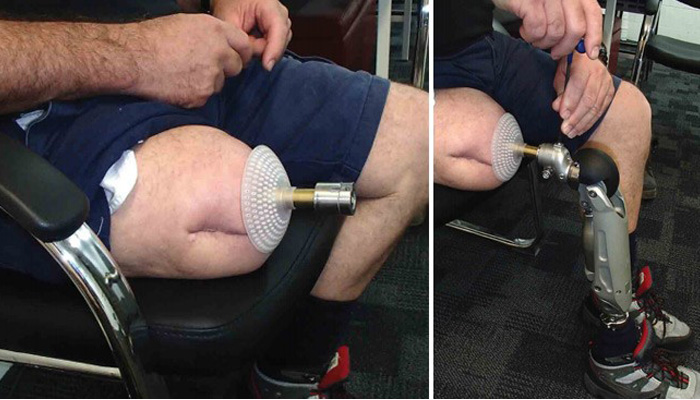
Amputation treatment
This new technique goes back to well-established findings of tooth-implants. The main idea is a bone-anchored and skin penetrating implant that allows the attachment of an artificial knee-joint and lower leg prosthesis. It therefore essentially differs from the conventional socket-prosthesis and can provide remarkable advantages for a suitable patient. By now the procedure can also be performed for lower leg amputees and has therefore proved its value …


